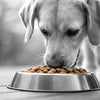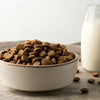What is Considered the Best Dry Dog Food? A Comprehensive Guide
- Houndsy
Table of Contents
- Introduction
- Understanding Quality Ingredients
- Nutritional Needs of Your Dog
- Top Brands and Products
- Feeding Practices for Optimal Health
- Conclusion
Introduction
Did you know that approximately 60% of dog owners struggle to find the right food for their furry friends? With a plethora of options available in the market, it can feel overwhelming to determine what is considered the best dry dog food. As passionate pet owners ourselves, we understand the importance of providing our dogs with high-quality nutrition that supports their overall health and well-being.
In this blog post, we will dive deep into the world of dry dog food, exploring what makes a kibble truly exceptional. We'll discuss key ingredients, nutritional needs, and how to select the best option for your dog’s specific requirements. By the end, you will have a clearer understanding of how to choose the right dry dog food, ensuring that mealtime becomes a delightful experience for both you and your pet.
Our focus will include the following aspects:
- Ingredients to Look For: Understanding what constitutes quality ingredients in dry dog food.
- Nutritional Needs: How to assess your dog’s specific dietary requirements based on their age, breed, and activity level.
- Top Brands and Products: A review of popular dry dog food brands that align with our high standards of quality and reliability.
- Feeding Practices: Tips for transitioning to new food and establishing a feeding routine that promotes health and happiness.
We invite you to reflect on your own pet feeding routines as we take this journey together. Let’s explore what truly makes for the best dry dog food!
Understanding Quality Ingredients
When it comes to dog food, the ingredient list is your best friend. The first step in identifying what is considered the best dry dog food is to understand the ingredients that go into it.
What to Look For
- High-Quality Proteins: Look for named meat sources (e.g., chicken, beef, lamb) as the first ingredient. Avoid vague terms like "meat by-products," which can indicate lower quality.
- Whole Grains vs. Grain-Free: Depending on your dog’s dietary needs, whole grains like brown rice and oatmeal can provide essential carbohydrates and fiber. However, some dogs may do better on grain-free options, especially if they have sensitivities.
- Healthy Fats: Ingredients such as chicken fat, fish oil, or flaxseed are great sources of omega fatty acids, which promote healthy skin and a shiny coat.
- Fruits and Vegetables: Ingredients like sweet potatoes, blueberries, and carrots provide vitamins, minerals, and antioxidants that support overall health.
- Avoid Fillers and Artificial Additives: Stay away from foods that contain excessive fillers like corn and soy, as well as artificial colors, flavors, or preservatives.
Reading the Label
Familiarize yourself with the Association of American Feed Control Officials (AAFCO) guidelines. Look for a nutritional adequacy statement on the label that confirms the food is "complete and balanced" for your dog’s life stage (puppy, adult, or senior).
Nutritional Needs of Your Dog
Every dog is unique, and their nutritional needs can vary widely based on several factors. Understanding these factors will help you choose the best dry dog food for your furry companion.
Age and Life Stage
- Puppies: Require higher protein and fat levels to support growth and development. Look for formulas specifically designed for puppies.
- Adults: Maintain energy levels and muscle mass. Adult formulas typically have balanced nutrients to support overall health.
- Seniors: May benefit from lower fat content and added joint support ingredients like glucosamine.
Breed and Size Considerations
Different breeds have different energy levels and nutritional needs:
- Small Breeds: Often need higher calorie density due to their fast metabolisms.
- Large Breeds: Should be fed diets lower in fat to prevent obesity and joint issues.
Activity Level
If your dog is highly active, they may require higher protein and fat levels, while less active dogs should have a diet focused on maintaining a healthy weight.
Top Brands and Products
As we assess what is considered the best dry dog food, we must highlight some of the top brands that have gained recognition for their quality and reliability. Our reviews are based on ingredient quality, customer reviews, and nutritional value.
Houndsy Kibble Dispenser: Elevating Mealtime
Before we dive into specific brands, we want to introduce you to our Houndsy Kibble Dispenser. Designed with both functionality and style in mind, this dispenser not only ensures perfect portion control but also adds a touch of elegance to your home décor. With its ergonomic crank at standing height, it eliminates the need for bending, making mealtime a breeze for both you and your pup. Explore more about the Houndsy Kibble Dispenser here.
Recommended Brands
- Blue Buffalo: Known for its high-quality ingredients and various life stage options, Blue Buffalo offers a range of formulas that cater to different dietary needs.
- Wellness: This brand focuses on natural ingredients and provides various grain-inclusive and grain-free options to suit your pet's preferences.
- Orijen: A pioneer in biologically appropriate foods, Orijen uses fresh, regional ingredients to create nutrient-dense diets that mimic a dog's natural diet.
- Taste of the Wild: Featuring unique protein sources and wholesome grains, this brand is popular among pet owners seeking quality and affordability.
- Purina Pro Plan: With a variety of specialized formulas, Purina Pro Plan caters to specific health needs, ensuring that dogs receive tailored nutrition.
Evaluating Product Claims
When selecting a dry dog food, be cautious of marketing claims that sound too good to be true. Always refer to the ingredient list and nutritional information to make informed decisions.
Feeding Practices for Optimal Health
Once you’ve chosen the right dry dog food, establishing a consistent feeding routine is vital for your dog’s health.
Transitioning to New Food
If you’re switching to a new brand or formula, do so gradually over a week to avoid digestive upset. Start by mixing a small amount of the new food with the current food, gradually increasing the new food's proportion.
Establishing a Feeding Schedule
Determine the best feeding schedule for your dog—whether it's once or twice a day. Consistency helps regulate digestion and can prevent overfeeding.
Monitoring Portion Sizes
Use the feeding guidelines provided on the dog food package as a starting point. Adjust portions based on your dog’s activity level, age, and body condition.
Regular Vet Check-ups
Regular veterinary visits are essential to ensure your dog is thriving on their diet. Your vet can help assess whether the food you’ve chosen continues to meet your dog’s nutritional needs.
Conclusion
Choosing what is considered the best dry dog food involves a careful evaluation of ingredients, nutritional needs, and brand reliability. By understanding these elements, we can provide our furry friends with the nourishment they deserve, enhancing their health and happiness.
As we wrap up this discussion, we encourage you to reflect on your dog’s dietary habits. Are you currently providing the best nutrition for your companion? If you’re looking to elevate your feeding routine, consider the convenience and style of our Houndsy Kibble Dispenser. Explore more here.
Frequently Asked Questions
1. How do I know if a dry dog food is high quality?
Look for named meat ingredients, avoid fillers or artificial additives, and ensure the food meets AAFCO standards for nutritional adequacy.
2. Can I feed my dog a grain-free diet?
Grain-free diets can be suitable for some dogs, especially those with grain sensitivities. However, consult with your veterinarian before making any significant dietary changes.
3. How much dry dog food should I feed my dog?
Refer to the feeding guidelines on the packaging as a starting point, and adjust based on your dog’s age, activity level, and body condition.
4. What are the signs of a food allergy in dogs?
Common signs include itching, skin problems, gastrointestinal issues, and changes in behavior. If you suspect a food allergy, consult your veterinarian for advice.
5. How often should I feed my dog?
Most adult dogs do well with two meals a day, while puppies may require three to four smaller meals. Consistency is key for digestion.
By understanding the nuances of dog nutrition and feeding practices, we can make informed decisions that positively impact our pets' lives. Let’s continue to provide our dogs with the best care possible!












